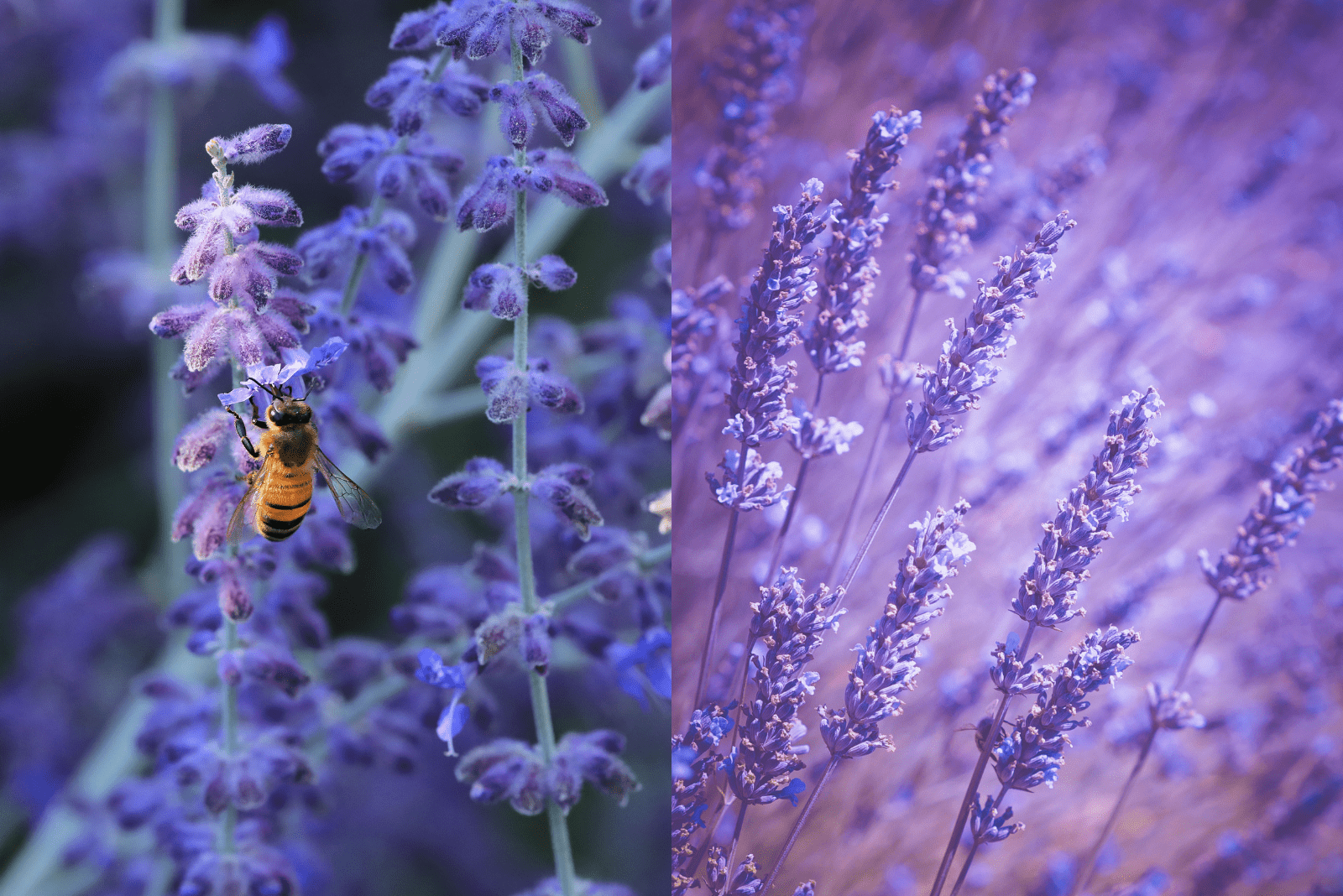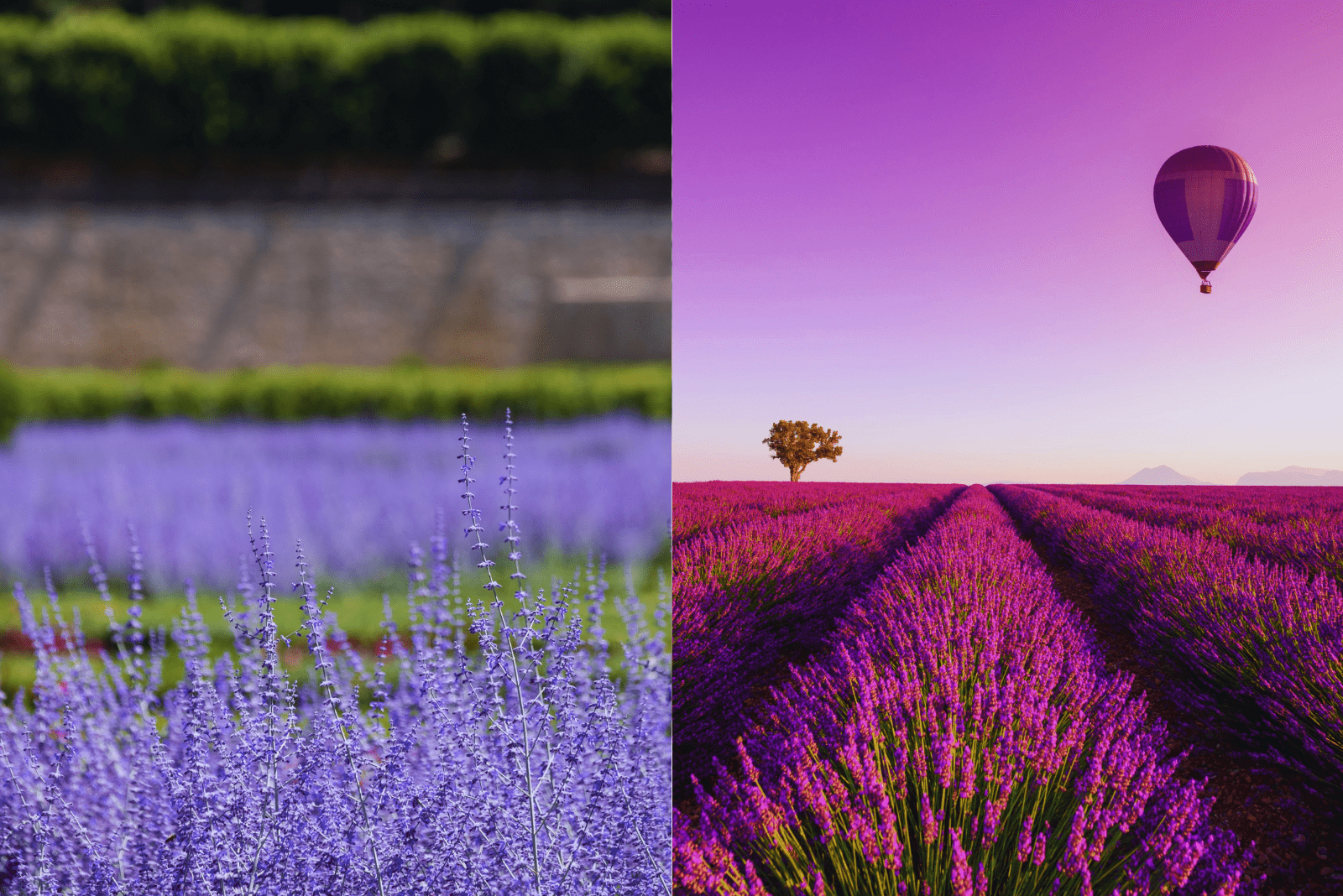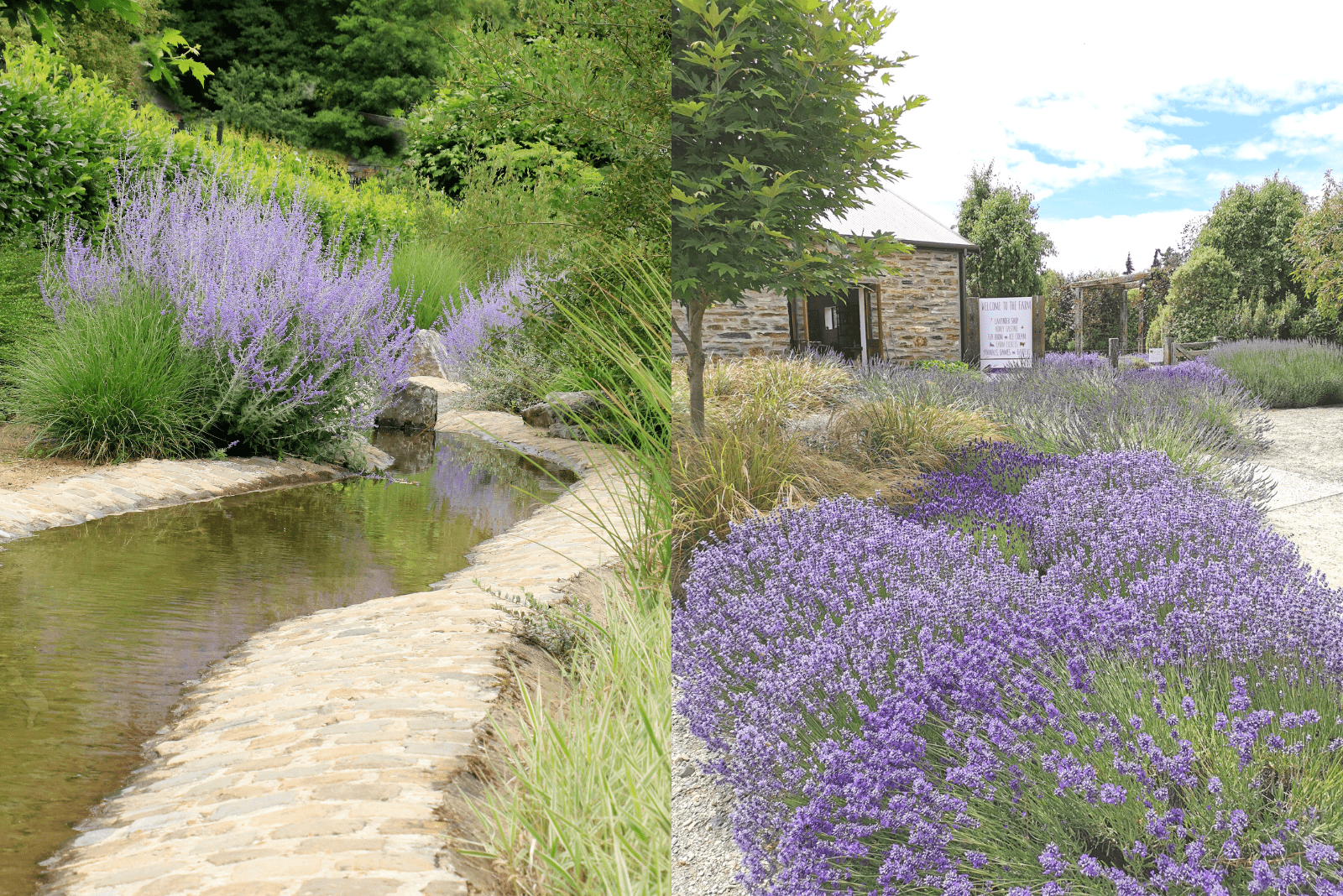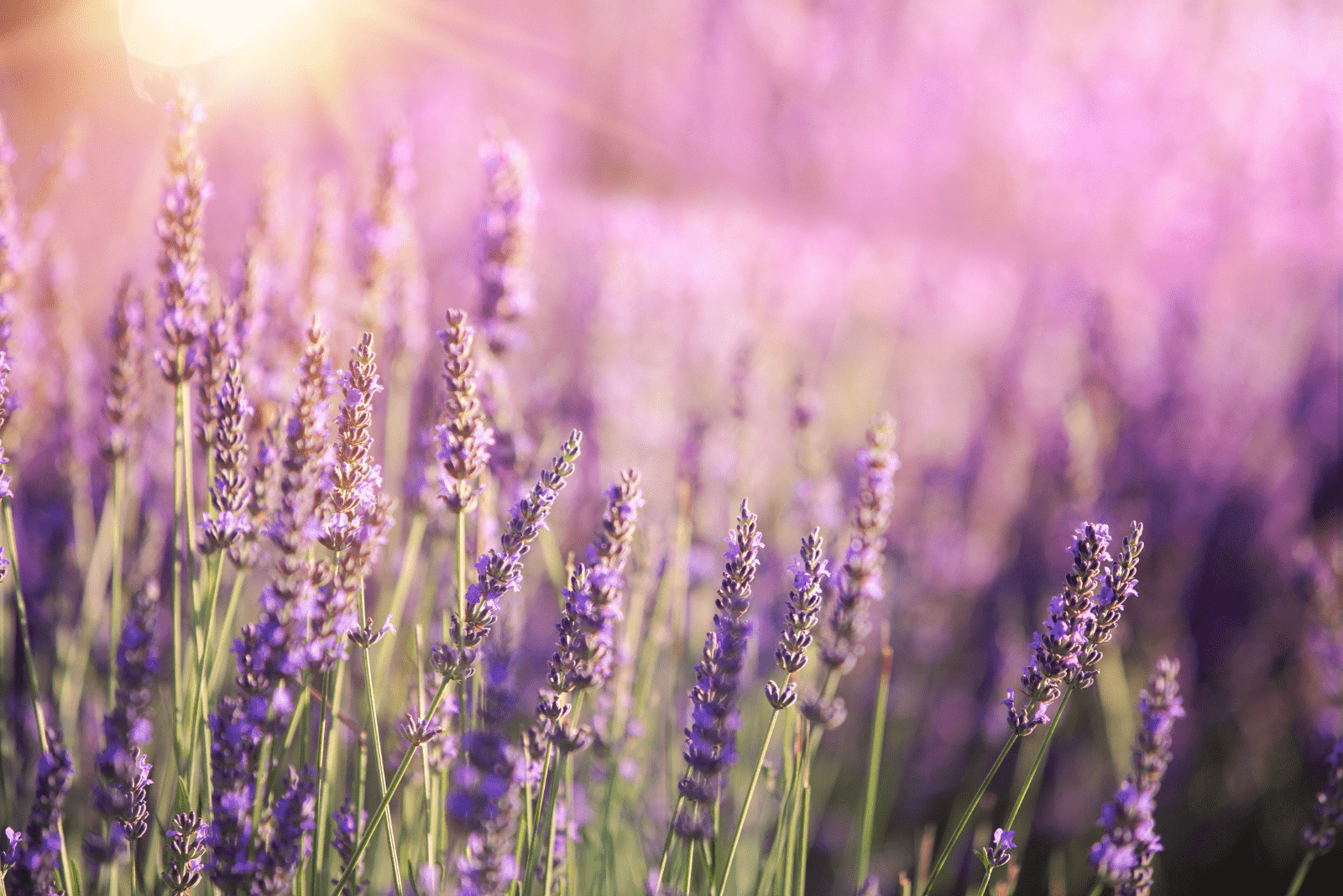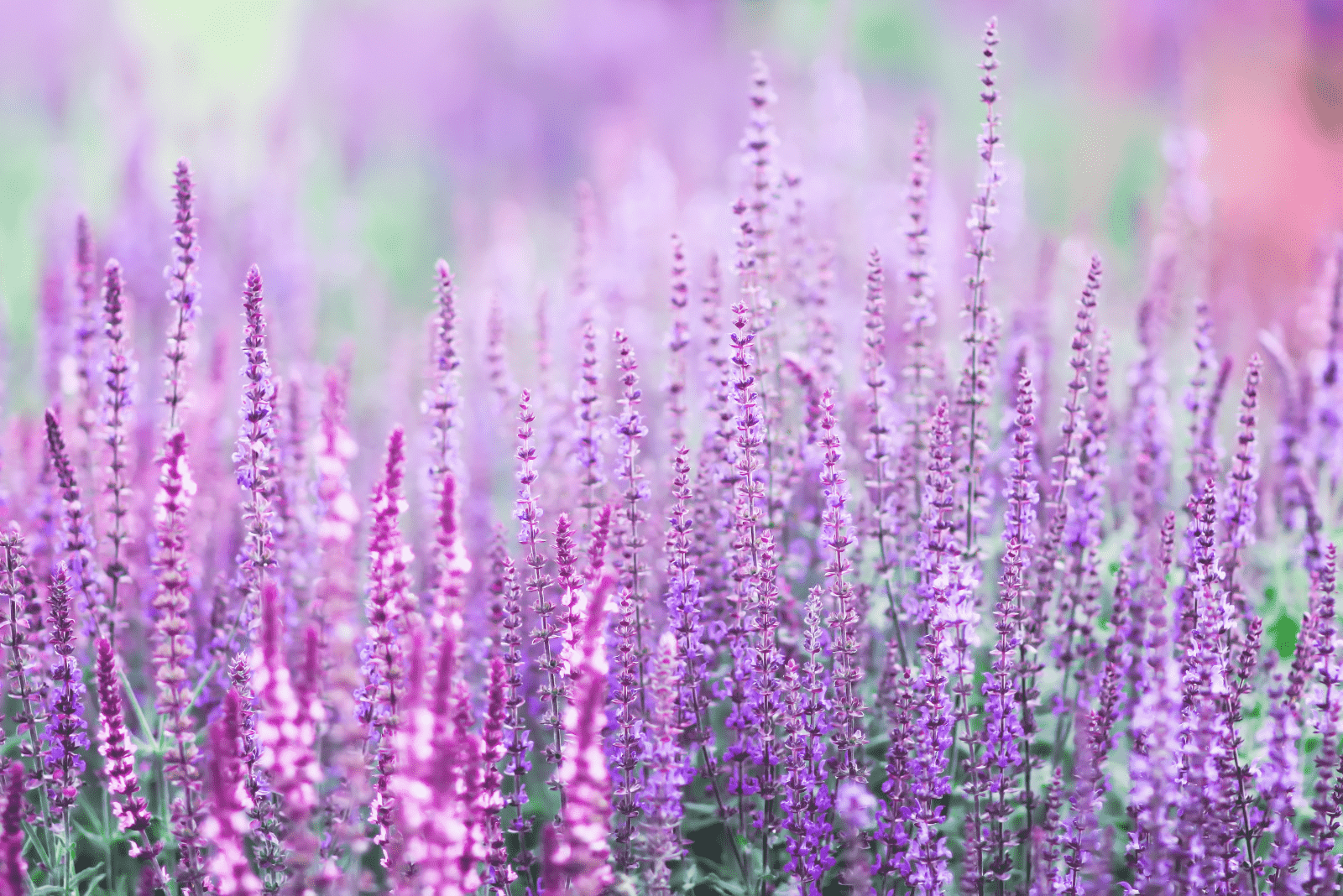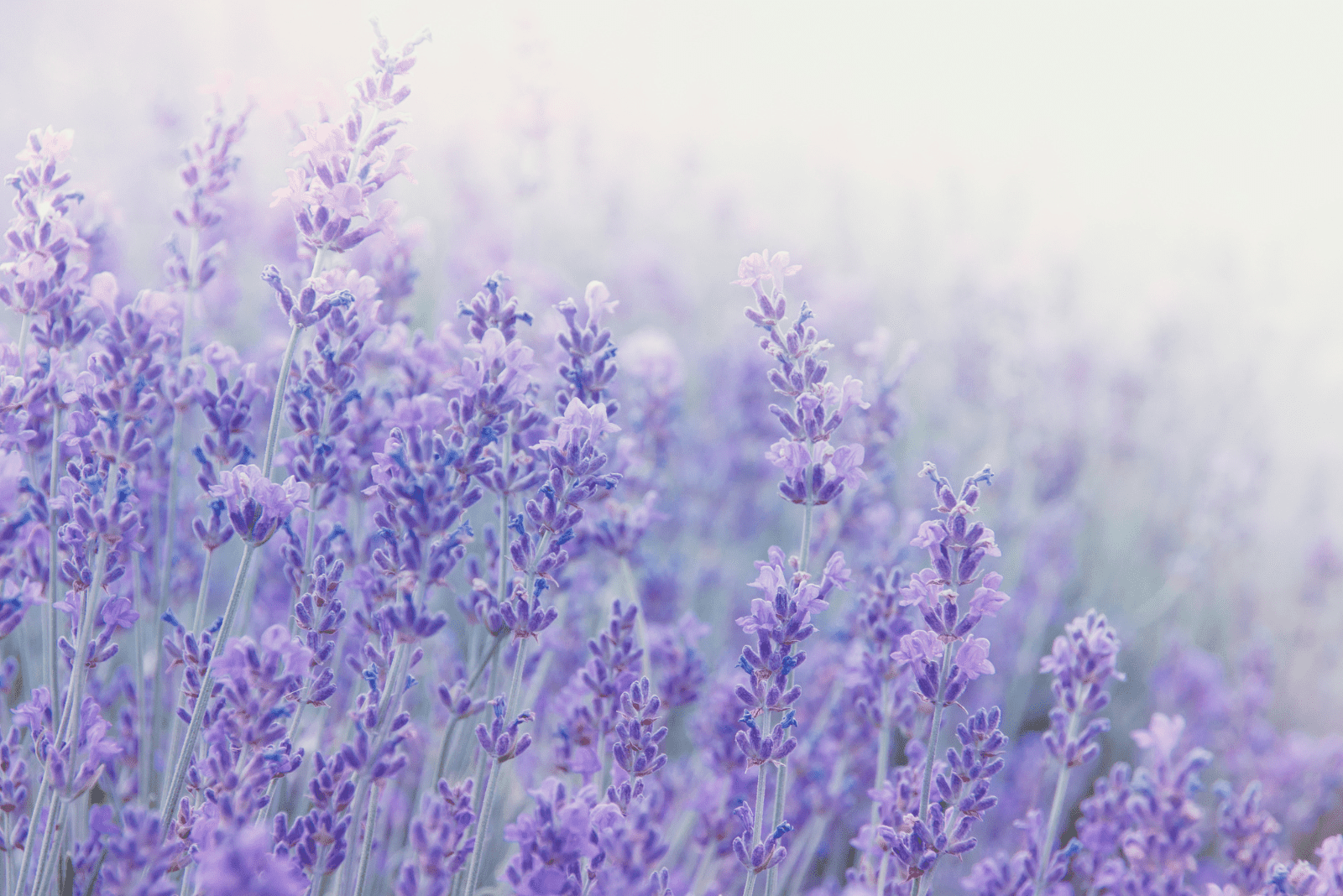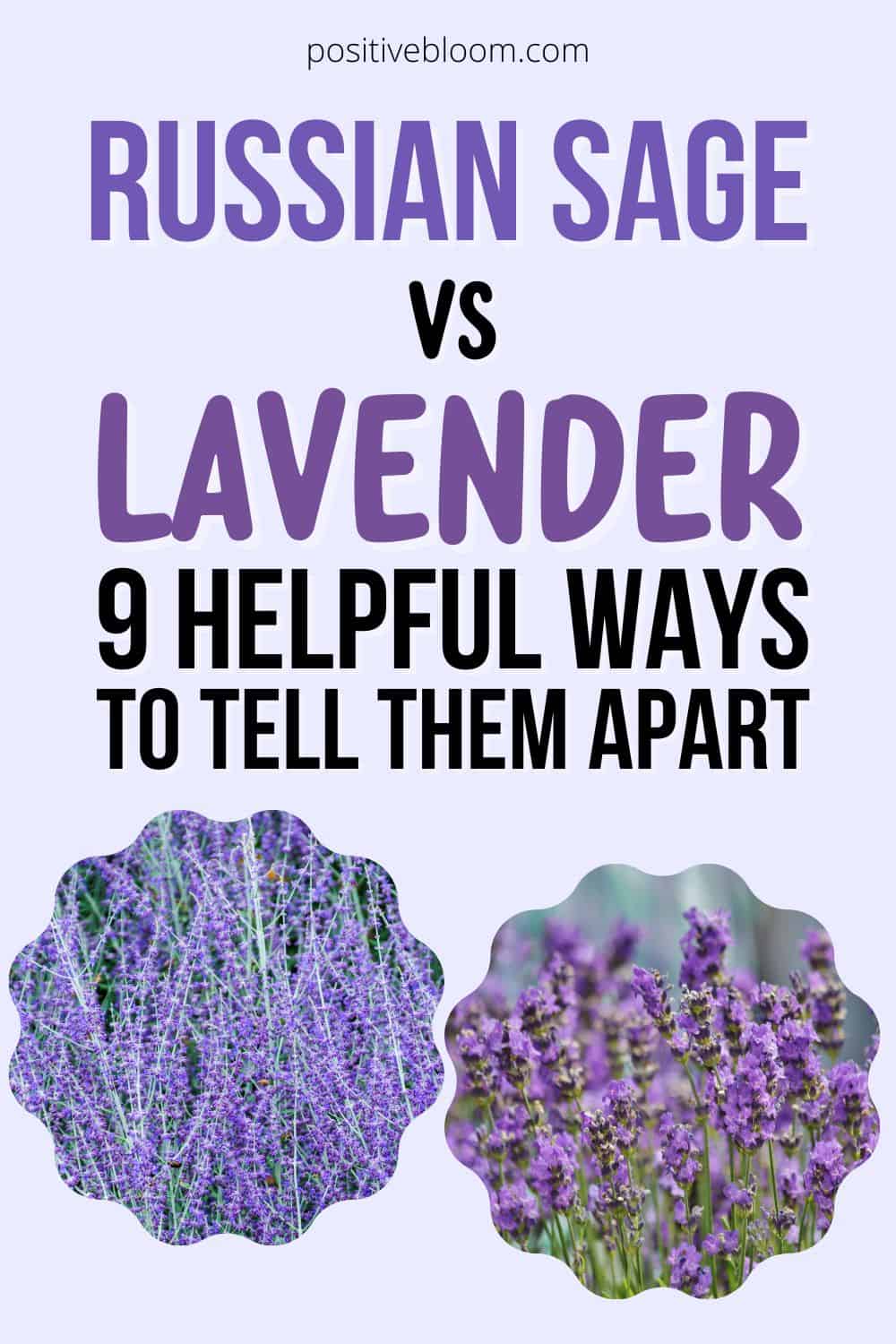Both lavender and Russian sage are garden plants adored by growers around the globe, and they are frequently mistaken for one another because they look alike.
However, there are many differences between Russian sage vs lavender that can help you distinguish between them.
Even though they look alike, their leaves and flowers are quite different, they don’t bloom at the same time, and they have different nutritional values.
On the other hand, these plants share some similarities as well. They have the same needs, applications, and are harvested the same way.
There are many varieties of sage and lavender, but in this article, we will limit ourselves to the differences between Russian sage and the most common lavender types: English lavender , French lavender , and Spanish lavender .
Before we start, let’s look at an overview of the differences and similarities between these two subshrubs :
[table id=211 /]
Russian Sage vs Lavender: The 9 Main Differences
There are nine main differences between Russian sage and lavender plants , and we’ll discuss each of them in more detail.
The main things that distinguish them are primarily their color and size, but the shape of their flowers and foliage is a good tell as well.
Even though they have virtually the same needs, they don’t thrive in the same hardiness zones .
We’ll finish up by talking a bit about the differences in their nutritional content and health benefits so that you can decide which one is worthy of adorning your backyard (it’ll probably be both!).
1. Color Of The Flowers
The easiest way to tell the difference is by simply examining the color of the flowers a bit more closely.
You’ll notice that lavender is usually a light or dark shade of blue or purple , depending on the variety.
However, people love experimenting and exploring the unknown, which is why there are so many different hybrid lavender varieties or lavender cultivars with pink, white, or even yellow flowers.
Meanwhile, Russian sage usually produces blue flowers with just a hint of purple.
Therefore, lavender is definitely a better option if you want more diversity.
2. Flower Shape And Size
Speaking of flowers, the shape and size also differ, and you’ll learn to recognize the inflorescence of these plants more easily with each passing day.
Lavender flowers are smaller than those of Russian sage and are usually only half an inch in diameter. Its spiky inflorescence resembles rye – only the grains are replaced with tiny flowers composed of five petals each.
The attractive flowers grow quite close to each other because lavender doesn’t produce lateral flower stalks .
Lavender stems are shorter than those of the Russian sage and usually grow between 5-10 inches tall (although they can be taller, depending on the climate and the variety).
The spikes are different from lavender’s because the main stem branches and grows tiny flower stalks, which are usually 4 inches long. These short stems bear many flowers and form a majestic panicle approximately 13 inches long.
Russian sage flowers are still tiny, but twice as large as lavender’s with a diameter of up to an inch.
Both plants attract many pollinators to your garden, so you’ll benefit from either of them.
3. Blooming Time
These two subshrubs don’t bloom at the exact same time, so if you want color in your garden for most of the year, you should read through this section and learn which plant has a longer blooming period.
If you are wondering when lavender bloom s, you may find conflicting answers, but that’s only because different lavender species flower at slightly different times.
You can expect English lavender (Lavandula angustifolia) to show its deep purple flowers some time in early summer and continue flowering up to October if all its requirements are met.
French lavender starts flowering in early spring and continues well into the summer. Finally, Spanish lavender will adorn your garden with its fascinating colors from late spring to fall if the weather conditions are perfect.
The Russian sage plant has a short blooming period. In warmer climates, it may flower from mid-summer to September or even early October. However, in colder weather, this period shortens, and you’ll be able to enjoy mesmerizing tubular flowers for just several weeks.
If you want to enjoy purple shades for most of the year, you should go with lavender. However, Russian sage can add depth and nuance to your garden, so you should plant it alongside lavender.
4. Size Of The Shrub
One of the easiest ways to distinguish between these plants is by examining their size. Lavender is shorter and usually reaches a height and width of 20-24 inches , although 30-inch tall lavender isn‘t unheard of.
Russian sage, on the other hand, usually reaches a height of 2-3 feet. However, many shrubs can extend up to 5 feet and spread up to 4 feet, which makes sage twice as tall as lavender.
It’s up to you to decide whether you want a compact lavender hedge or to go with the lush look of Russian sage .
5. Leaves
The leaf size is the same for both plants (around 2 inches long), but their color and content differ .
Lavender leaves can be green, gray-green, and even green-purple, depending on the species. English lavender usually produces gray leaves, while French lavender has green foliage that changes its color as it grows old and becomes silvery-gray. Finally, Spanish lavender usually grows long and narrow grey-green leaves .
On the other hand, Russian sage usually has gray-green foliage that is slightly elongated.
The “content” of the leaves is also different, and even though their scent is similar, it isn’t the same when it comes to the strength.
Lavender has a stronger scent and juicer leaves that release their essence and fill the entire room with their fragrance when crushed. Russian sage leaves are also quite fragrant, but their scent is much less aromatic, which makes lavender the preferred choice of many growers .
6. Hardiness Zone
Even though both plants thrive in warm climates and require plenty of sunlight, they still have some preferences.
Lavender is less hardy than Russian sage and can grow in USDA zones 5-9 , but this depends on the variety. French lavender (Lavandula dentata) is hardy in zones 8-11, whereas Spanish lavender (Lavandula stoechas) grows in USDA zones 6-11.
Russian sage is quite a cold-hardy plant compared to lavender and grows in USDA zones 4-9. It can handle winter conditions quite well, and you won’t have to provide it with any protection in these zones.
Lavender needs winter protection to survive, especially the French and Spanish varieties. English lavender is more cold-hardy than these types and can endure USDA zones 5-9. However, it is sensitive to biting winds, so you should shelter it from harsh winter conditions.
I’d say that this round goes to Russian sage as it’s more tolerant of extreme conditions, but it’s your choice nevertheless. If you live in warm climates , you don’t have to worry about hardiness that much.
7. Background And Origin
One of the main reasons we have trouble telling these plants apart is definitely due to their lineage. Both plants are members of the mint family – scientifically known as Lamiaceae , but they belong to different genera.
Russian sage belongs to the Salvia genus, whereas lavender has its own genus – Lavandula.
Russian sage didn’t always belong to the Salvia genus and was formerly known as Perovskia atriplicifolia . It was named after the governor of a Russian province, which is probably why we still refer to it as Russian sage . It was reclassified in 2017, and its name has been changed to Salvia yangii .
It is native to Central Asia and countries such as Pakistan and Afghanistan but can also be found in Tibet.
Lavender’s native habitat ranges from the Mediterranean , across the south and tropical Africa, and to the east in India.
8. Nutrition And Benefits
Russian sage has many health benefits, such as reducing fever, helping your digestive system, improving sleep and helping with relaxation, repelling bugs, managing blood circulation, and symptoms of diabetes.
Its benefits are mainly due to the many nutrients and minerals packed in those tiny leaves and flowers. It contains plenty of iron, which helps with blood circulation, and magnesium, which can help you relax.
It also contains calcium, which is essential for bone health, and manganese, which helps with the formation of connecting tissue and blood and regulates blood sugar.
Lavender doesn’t contain as much of these minerals as Russian sage , but it has other benefits. It is everyone’s favorite skincare ingredient as it helps with skin blemishes, eases inflammations, and encourages hair growth.
There are many studies that indicate lavender can help with high blood pressure and heart rate, asthma, pain, and even menopausal flashes, but more research needs to be done on these topics.
What we can say is that it is a great relaxant and can help you sleep better (although, it doesn’t treat insomnia).
It is a great natural weapon against mosquitoes, moths, and other bugs. In fact, it is so fragrant that you don’t even have to crush its leaves or use lavender essential oil ; simply put a few branches in your closet or near windows, and your home will be bug-free before you know it (unless you’re dealing with a whole new variant of mutated insects)!
9. Toxicity
The last difference between these plants is their toxicity. Even though neither of them poses a danger to humans, lavender is toxic to pets, according to the ASPCA.
It contains a substance called linalool, which may have harmful effects on cats and dogs. However, the amount of linalool isn’t huge, and your pet would need to ingest large quantities in order to get sick.
Linalool can lead to vomiting, diarrhea, seizures, and even more serious conditions, so monitor your pets around lavender.
Russian sage is considered non-toxic and is an ideal plant for a pet-friendly garden.
Russian Sage vs Lavender: Similarities
The good news about these plants is that they have nearly the same care guides, which makes them perfect companion plants .
You can also harvest them in the same way and use them interchangeably. However, lavender is more fragrant, so if you‘re looking for a pleasant aroma, you should probably use lavender instead of Russian sage .
Care Guide
These low-maintenance plants require plenty of sunlight, a bit of water, slightly alkaline soil, and that’s it!
However, there’s more to it than just sun, water, and soil – you need to know when and how to prune and propagate them if you want to see new growth and breathe some life into your live hedge.
Stick with us to learn how to properly care for these plants.
Light Requirements
Both plants require full sun to thrive, so plant them somewhere they can get at least 6-8 hours of sunlight a day.
Understanding lavender growth stages will come in handy because it has different needs at different stages. For instance, lavender needs much more water when young.
Plant lavender and Russian sage where they won’t be shaded by tall trees throughout the day.
Of course, if the temperatures are unbearable and the Sun makes you swoon, you should give these warmth-loving plants some shade in the afternoon, or they might get burned.
Finally, neither of these plants can tolerate prolonged exposure to shady places; their growth rate will slow down, and they may even stop flowering, so make sure you keep them away from deep shade.
Water And Humidity
The good news about lavender and Russian sage is that they are drought-tolerant plants and can go for quite a long time without water.
However, you need to water them regularly throughout their first growing season to promote the development of deep and strong root systems . Once the plants are established, they don‘t need to be watered more than twice a week.
Furthermore, if you live in a region that gets its fair share of rain, you don’t have to worry about irrigation at all.
The rule of thumb is to wait until the soil has dried completely before watering these plants, and if there’s been rain (or soon will be), wait until the soil is dry before adding more water.
These plants thrive in medium to dry substrates, and too much water can lead to root rot, which may kill your shrubs.
If you live in a climate with mild winters and have decided to grow Russian sage or lavender outdoors, you won’t have to water them at all. However, if you have chosen to plant them in containers, you should give them a few drops of water once every month or a month and a half, depending on how quickly the soil dries out.
Humidity
If we look at the native habitats of these two plants, we’ll see they have one thing in common: they aren’t particularly humid places.
These subshrubs are used to arid climates, and too much moisture in the air or soil can be detrimental.
They thrive in drier climates but can survive moderate humidity if you ensure there’s enough air circulation.
Therefore, if you live in more humid climates (but not tropical or subtropical areas), plant these shrubs a few feet away from each other.
Temperature
Both plants prefer warm temperatures between 70-75°F. However, that’s rarely possible even in their native habitats, so they developed some resistance to heat and can flourish in temperatures between 68-86°F.
Russian sage is a bit more cold-hardy than lavender and can tolerate temperatures as low as 20°F or less, and temperatures of 35-44°F can actually enhance germination.
Meanwhile, lavender can survive temperatures as low as 45°F , but you shouldn’t expose it to weather colder than that as it can be quite harmful.
Of course, there are cold-hardy lavender varieties that are said to survive temperatures as low as -20°F.
It’s important to remember to mulch your plants to help them survive the winter. This method keeps their roots safe from freezing.
Finally, if you have decided to grow these plants indoors, ensure you don’t place them near AC, heaters, etc., because they cannot handle the draft.
Soil And Fertilizer
Both lavender and Russian sage prefer soil pH that is mildly alkaline, between 7.0-8.0. However, lavender can tolerate a broader range of soil conditions and survive even in slightly acidic soils.
As both plants prefer pH levels above 7.0, make sure you add some lime to amend your garden soil and make the nutrient absorption more effective.
One of the great things about these subshrubs is that they can tolerate a wide range of growing mediums, from clay to sandy soils.
However, their watering frequency should be adjusted to the type of substrate you have planted these members of the mint family in. Therefore, if you grow them in sandy soils, make sure to water them more frequently as water infiltrates sand faster than clay.
On the other hand, if the growing substrate is heavy and clay-based, you should water these plants less to avoid root rot.
Finally, the soil shouldn’t be too rich because lavender and Russian sage don’t like organic content and nutrients that much. They favor poor growing mediums, which is another great thing as it means you won’t have to fertilize these plants too often.
Fertilizer
Speaking of fertilizer, you should know that these plants can go quite some time without being fertilized.
You can encourage their growth by adding some plant food once a year. We like to add some compost at the base of the plant, or you can use a slow-release all-purpose fertilizer.
You should fertilize these plants once a year in spring or even every other year if the soil you have planted them in is fertile enough on its own.
Pruning
Pruning both lavender and Russian sage is of immense importance, especially if you want to prevent them from invading your yard and becoming woody. Regular trimming also encourages lush growth and productive flowering, which is just another plus.
The key thing is to cut back the old stems of both plants in spring once the new growth appears. You should cut your plants just above the lowest sets of leaves (remove 2/3 of the plants) and then leave them alone until summer.
After the plants bloom for the first time, they may struggle with producing more flowers, so you should trim the tips to promote more blue and purple flowers in your yard.
If the plants grow faster than they should, you can give them a good trim some time in the summer; just make sure you don’t cut more than 1/3 of the entire plant, or they will be too weak to deal with the cold winter conditions.
Don’t prune the plants in the late fall, and never go too close to the woody base of the plant as it’ll make it more vulnerable to harsh winds and freezing temperatures.
Finally, always use sterilized equipment when pruning to avoid transferring any bacteria that may harm your shrubs.
Here are some great tips for cutting back these plants in spring:
Propagation
Both shrubs can be propagated in the same ways; you can either use cuttings or divide the roots to grow more of these fragrant shrubs and plant the lavender hedge you’ve always dreamed of.
Below you will find our step-by-step guides for propagating these plants effectively. The best time to propagate these plants is during their growing seasons as that’s when they actively grow and can develop sturdier roots and stems to survive the winter.
Propagation From Cuttings
Step 1 . The first step is to take the cutting. Choose a young unflowered stem 3-4 inches long and cut it with a sterilized knife. You can take hard or soft cuttings, but there is a difference in the success rate.
Hardwood has a higher success rate long-term, but you shouldn’t take too many cuttings, or you might weaken the plant. On the other hand, softwood roots rather quickly, and you can take as many cuttings as you want.
Step 2. Remove the leaves from the lower half of the cut stem and scrape the skin on one side.
Step 3. Add some starting mix to the nursery pot or make your own by adding equal parts peat moss and perlite. You can also add some bark to improve drainage.
Step 4. Dip the skinned part of the cutting into the rooting hormone, which will facilitate rooting and prevent rotting.
Step 5. Plant the lower half and cover it with soil. Place the pots in a well-lit area where the temperatures aren’t lower than 60°F, and make sure to water them so that the substrate never dries.
Step 6. In a couple of weeks, you’ll notice that the cuttings have started growing, and once they reach 12 inches long, you can transplant them into your garden.
Propagation By Division
It’s pretty helpful to divide your Russian sage and lavender plants every 4-6 years as it allows you to control their growth and prevent them from invading your garden.
The best time to do it is in spring when the plants are actively growing and the shrubs aren’t flowering because that uses the plants’ energy, and they cannot fully focus on vegetative growth.
Step 1. Before digging up the plant, you should cut it back to make it easier. Combine spring pruning and dividing your plants into a single chore to make your life easier.
Step 2. You can have as many new plants as there are woody stems of the lavender. Separate the roots with your hands, slowly pulling them apart. Be careful not to cause too much damage to the roots!
Step 3. Dig some holes for your new shrubs as deep as their current root systems , add some fertilizer to the soil, and even compost or organic soil to give these plants a boost.
Pro tip: Divide your plants on a cloudy day so as to minimize shock.
The video below show provides some excellent tips for dividing lavender, and you can use that knowledge to divide your Russian sage as well:
Harvesting
Once the plants produce flowers, it is time to harvest them and make sachets, potpourri, repel bugs, etc.
Simply snip off the stems before the flowers fully open , and that’s it! Take as much as you need and leave the rest to decorate your yard.
You should be careful not to harvest woody stems as that can truly hurt your plants and cause rotting.
The best time for harvesting is when the blooms start appearing so the plant can continue flowering and produce a more viable yield.
Cut the stems early in the morning because the oils are more intense, and the heat won’t hurt the plants.
Application
Russian sage and lavender have the same applications and can be used for cooking and making essential oils.
For instance, you can make a tasty lavender lemonade by mixing sugar, warm water, and lavender flowers to make a syrup and then adding lemon juice and water to your taste.
When it comes to Russian sage , we prefer making tea from it. It not only smells and tastes amazing, but also has medicinal benefits such as soothing an upset stomach.
Both plants can repel insects, although lavender has a stronger scent, so it’s more effective.
Q&A Corner
Even though we have talked about many things concerning lavender and Russian sage , we know that you may still have some questions.
Therefore, we decided to investigate your inquiries and answer them to the best of our knowledge so that your lavender and Russian sage know-how is complete.
Let’s get started!
Does lavender go with Russian sage?
As both plants belong to the same family, you can use them together or alternately.
Just bear in mind that lavender is more potent than Russian sage , so adjust the quantity accordingly.
Does Russian sage smell like lavender?
Russian sage smells like sage, but it contains a slight hint of lavender fragrance as well.
However, its scent is much less intense than that of lavender, so you’ll need to pick much more Russian sage to get the same effect.
Does lavender work as a bug repellant?
Lavender is an excellent bug repellant that keeps mosquitoes and moths at bay. You can save your skin and clothes by simply hanging dried lavender around the house and in your closets.
Lavender is so fragrant that you don’t even have to burn it or crush its leaves in order for it to work.
However, if you want to make sure that the mosquitoes don’t bite you, you can simply crush some lavender leaves between your fingers to release the oils and rub them onto your skin.
Final Thoughts
This article brought you the nine main differences between Russian sage vs lavender, so you won’t have any problems distinguishing between the two from now on.
These differences may also help you decide which one to get. For instance, if you want more fragrant and compact plants, you should go with lavender. However, Russian sage is your go-to if you need a hardier plant.
These plants are also similar and have the same care guides and applications. Therefore, you can grow them side by side, harvest them when the time comes, and use them in cooking or for repelling bugs.
Hopefully, you can choose between the two, or better yet, cultivate both of them and turn your garden into a pollinator -friendly place.
Until next time!
Like this post? Share or pin it for later!

